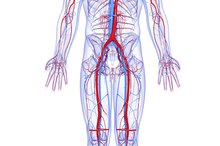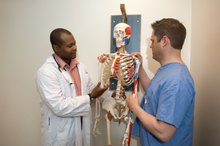How Does the Muscular System Work With the Immune System?
The most obvious and well-known of the muscular system's functions is movement. Muscles connect to the bones of the skeleton, and as they contract, they produce movement. A lesser-known purpose of the muscular system, however, is to help move body fluids--including blood and lymph--through the body. In this way, the muscular system assists in immune function.
If you are experiencing serious medical symptoms, seek emergency treatment immediately.
Immune System
The immune system is one of the body's most diverse and complex organ systems. It serves the purpose of protecting body cells from pathogenic attack and infection, and includes not only cellular components such as white blood cells, but organs as well. According to Dr. Gary Thibodeau in his book, "Anatomy and Physiology," the spleen and lymph nodes play important immunological roles 1. The spleen is a respository of immune cells through which blood passes, while the lymph nodes contain immune cells, and filter lymphatic fluid.
- The immune system is one of the body's most diverse and complex organ systems.
- The spleen is a respository of immune cells through which blood passes, while the lymph nodes contain immune cells, and filter lymphatic fluid.
Generation of Lymph
Differences Between Blood Vessels & Lymph Vessels
Learn More
Lymphatic fluid is the liquid component of blood. It's light yellow, or straw-colored, because it contains dissolved sugars and salts, but doesn't contain cells or many of the blood proteins. It's produced when fluid leaks out of small blood vessels, or capillaries, to surround cells. Much, but not all, of this fluid makes it back into the capillaries at the end of a capillary bed, Thibodeau reports. The fluid that doesn't re-enter capillaries returns to circulation via the lymphatic system, which is a subdivision of the immune system.
- Lymphatic fluid is the liquid component of blood.
- The fluid that doesn't re-enter capillaries returns to circulation via the lymphatic system, which is a subdivision of the immune system.
Lymphatic System
One of the major problems associated with human circulation of both blood and lymph is the upright posture adopted by humans. Because the heart is in the upper portion of the body, blood returning to the heart from the lower extremities has to fight gravity. Lymph, too, which must eventually re-enter circulation, has to reach the upper trunk against the force of gravity. Here, the muscular system plays an invaluable role. As muscles contract in the course of regular movement, they squeeze lymph upward, Thibodeau says. This keeps lymphatic fluid circulating, and the system remains functional.
- One of the major problems associated with human circulation of both blood and lymph is the upright posture adopted by humans.
- Lymph, too, which must eventually re-enter circulation, has to reach the upper trunk against the force of gravity.
Lymphatic Flow
The 4 Parts of the Cardiovascular System
Learn More
It's important that the lymphatic system remains functional because it serves both immune and circulatory roles. As lymph travels upward through the body toward the trunk, where it re-enters circulation with the blood, it passes through lymph nodes, where immune cells check it for invaders. If lymph didn't circulate, it would reduce the immune system's ability to function. Further, lymph represents a portion of the blood, meaning that if lymph weren't returned to circulation through the action of the skeletal muscles, blood volume would decrease, explains Dr. Lauralee Sherwood in her book, "Human Physiology. 2"
- It's important that the lymphatic system remains functional because it serves both immune and circulatory roles.
- Further, lymph represents a portion of the blood, meaning that if lymph weren't returned to circulation through the action of the skeletal muscles, blood volume would decrease, explains Dr. Lauralee Sherwood in her book, "Human Physiology.
Expert Insight
The importance of the muscular system in assisting the immune system by way of lymphatic flow becomes quite apparent any time an individual must stand or sit still for a long period of time. With the legs below the level of the heart, lymph must fight gravity to return to circulation. Without regular contractions of the leg muscles, however, lymph can't return to the upper body readily, and collects in the lower legs, producing uncomfortable swelling, called edema.
Related Articles
References
- “Anatomy and Physiology”; Gary Thibodeau, Ph.D.; 2007
- “Human Physiology”; Lauralee Sherwood, Ph.D.; 2004
- Randolph GJ, Ivanov S, Zinselmeyer BH, Scallan JP. The Lymphatic System: Integral Roles in Immunity. Annu Rev Immunol. 2017;35:31-52. doi:10.1146/annurev-immunol-041015-055354
- Choi I, Lee S, Hong YK. The new era of the lymphatic system: no longer secondary to the blood vascular system. Cold Spring Harb Perspect Med. 2012;2(4):a006445. doi:10.1101/cshperspect.a006445
- Cancer Research UK. The Lymphatic System and Cancer.
- Lu M, Munford RS. The Transport and Inactivation Kinetics of Bacterial Lipopolysaccharide Influence its Immunological Potency in vivo. Journal of immunology (Baltimore, Md: 1950). 2011;187(6):3314-3320. doi:10.4049/jimmunol.1004087.
- Mingozzi F, Spreafico R, Gorletta T, et al. Prolonged contact with dendritic cells turns lymph node‐resident NK cells into anti‐tumor effectors. EMBO Molecular Medicine. 2016;8(9):1039-1051.
Writer Bio
Kirstin Hendrickson is a writer, teacher, coach, athlete and author of the textbook "Chemistry In The World." She's been teaching and writing about health, wellness and nutrition for more than 10 years. She has a Bachelor of Science in zoology, a Bachelor of Science in psychology, a Master of Science in chemistry and a doctoral degree in bioorganic chemistry.








